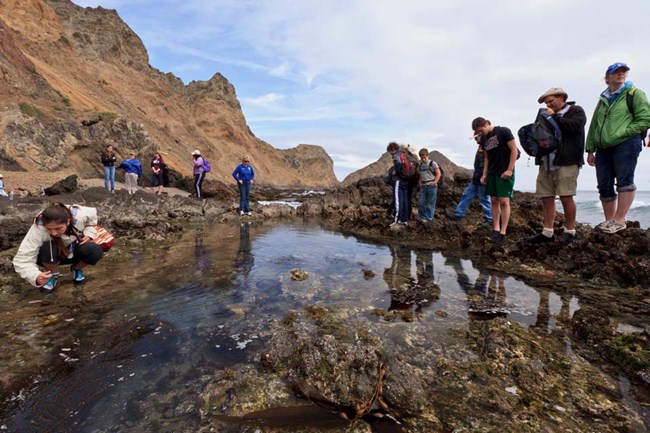
Due to their relative isolation and protection, the tidepools in Channel Islands National Park are some of the best within southern California. Anemones, sea stars, urchins, limpets, periwinkles, chitons, barnacles, mussels, and many other beautiful species can be seen at numerous pristine tidepool sites. The most accessible sites include: Frenchy's Cove on Anacapa Island; Smuggler's Cove on Santa Cruz Island; Becher's Bay at the pier, Southeast Anchorage, East Point on Santa Rosa Island; eastern end of Cuyler Harbor on San Miguel Island. For more information about specific tidepool locations, please visit Places To Go and read the the "Things To Do" section for each individual island. Also, check with the park's boat and plane concessionaires for trips to these tidepooling areas. The area between the land and the sea is not distinct, but is a zone of transition. This area may be covered with water during high tide or exposed to sunlight during low tide. Life in this intertidal region must be the hardiest within the marine environment-able to withstand hours of exposure and the incessant pounding of the energy-filled surf. Intertidal life has adapted to the sea and the land. When looking at a tidepool area, notice how plants and animals may be found in certain areas and not in others. Those living in the upper splash zone are tolerant to sunlight, heat, and water loss and have either a means to "shelter" themselves or the ability to move into an area of greater moisture. An animal with a tightly closed shell or a shell firmly attached to rock will hold water within, so that it does not require water surrounding it at all times. Animals found in rock crevices and submerged pools usually require more moisture to prevent them from drying out. How an animal feeds often depends on its ability to move. An animal that moves about is able to search for its food. Some graze the rocks for algae, while others feed on settled debris. An animal that remains stationary feeds on food particles suspended within water. Because space is a limiting factor, there is competition between organisms. Many animals and plants are found in a small area, some may live on each other, or use an old shell as a surface on which to live. This is one important reason why collecting is not permitted-you may be taking away a home. Although hardy against the forces of nature, the plants and animals of the intertidal zone cannot entirely endure the impact of humans. Since individuals interact with one another, minute changes in the area could disrupt the entire community. While exploring, please keep in mind these tidepool tips:
|
Last updated: May 26, 2016
